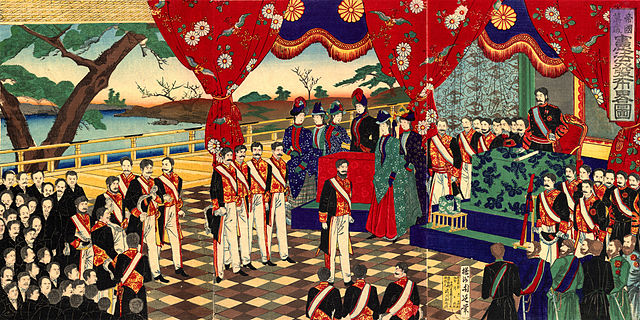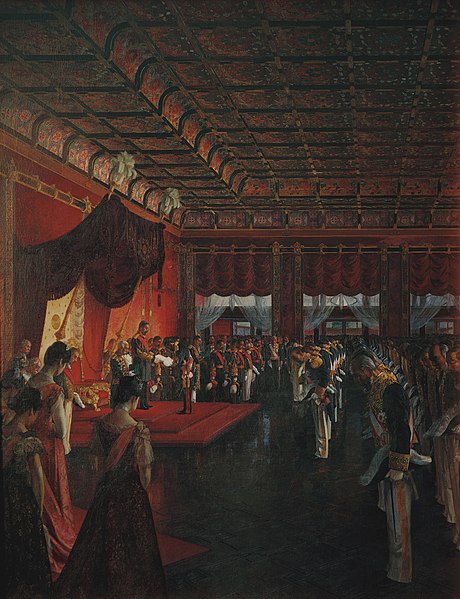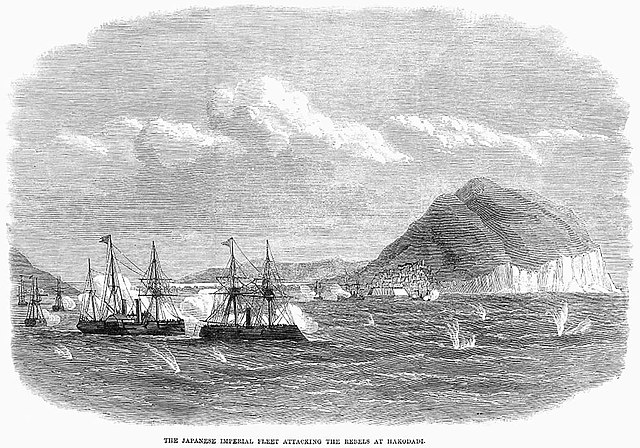The Constitution of the Empire of Japan, known informally as the Meiji Constitution, was the constitution of the Empire of Japan which was proclaimed on February 11, 1889, and remained in force between November 29, 1890, and May 2, 1947. Enacted after the Meiji Restoration in 1868, it provided for a form of mixed constitutional and absolute monarchy, based jointly on the German and British models. In theory, the Emperor of Japan was the supreme leader, and the Cabinet, whose Prime Minister would be elected by a Privy Council, were his followers; in practice, the Emperor was head of state but the Prime Minister was the actual head of government. Under the Meiji Constitution, the Prime Minister and his Cabinet were not necessarily chosen from the elected members of parliament.
Meiji Constitution promulgation by Toyohara Chikanobu
Conference on Drafting a Constitution by Goseda Hōryū [ja], showing Itō Hirobumi explaining the draft to the Emperor and the Privy Council in June 1888 (Meiji Memorial Picture Gallery)
Ceremony for the Promulgation of the Constitution by Wada Eisaku, showing the Emperor presenting the Constitution to Prime Minister Kuroda Kiyotaka at a ceremony in the Imperial Palace on 11 February 1889 (Meiji Memorial Picture Gallery)
Grand Parade to Celebrate the Constitution, also on the day of promulgation, by Katata Tokurō [ja] (Meiji Memorial Picture Gallery)
The Empire of Japan, also referred to as the Japanese Empire, Imperial Japan, or simply Japan, was the Japanese nation-state that existed from the Meiji Restoration in 1868 until the enactment of the reformed Constitution of Japan in 1947. From 29 August 1910 to 2 September 1945, the Empire of Japan included the naichi and the gaichi. It also ruled colonies such as Kwantung, South Seas, Mantetsu, and its concessions. The naichi was under Japanese direct rule while the gaichi was not, however both were parts of the empire. In the closing stages of World War II, with Japan defeated alongside the rest of the Axis, on 2 September 1945 the formalized Japanese Instrument of Surrender was issued in compliance with the Potsdam Declaration of the victorious Allies; and Japanese territory was immediately much reduced when lost Taiwan, Korea, Kuril and Karafuto as it is today.
The Naval Battle of Hakodate, May 1869; in the foreground, Kasuga and Kōtetsu of the Imperial Japanese Navy
Emperor Meiji, the 122nd emperor of Japan
Prominent members of the Iwakura mission. Left to right: Kido Takayoshi, Yamaguchi Masuka, Iwakura Tomomi, Itō Hirobumi, Ōkubo Toshimichi
Ōura Church, Nagasaki


![Conference on Drafting a Constitution by Goseda Hōryū [ja], showing Itō Hirobumi explaining the draft to the Emperor and the Privy Council in June 188](https://upload.wikimedia.org/wikipedia/commons/thumb/7/7c/Conference_on_Drafting_a_Constitution_by_Goseda_Horyu_%28Meiji_Memorial_Picture_Gallery%29.jpg/555px-Conference_on_Drafting_a_Constitution_by_Goseda_Horyu_%28Meiji_Memorial_Picture_Gallery%29.jpg)

![Grand Parade to Celebrate the Constitution, also on the day of promulgation, by Katata Tokurō [ja] (Meiji Memorial Picture Gallery)](https://upload.wikimedia.org/wikipedia/commons/thumb/c/c9/%E7%89%87%E5%A4%9A%E5%BE%B3%E9%83%8E%E7%94%BB%E3%80%81%E6%86%B2%E6%B3%95%E7%99%BA%E5%B8%83%E8%A6%B3%E5%85%B5%E5%BC%8F%E8%A1%8C%E5%B9%B8%E5%95%93.jpg/528px-%E7%89%87%E5%A4%9A%E5%BE%B3%E9%83%8E%E7%94%BB%E3%80%81%E6%86%B2%E6%B3%95%E7%99%BA%E5%B8%83%E8%A6%B3%E5%85%B5%E5%BC%8F%E8%A1%8C%E5%B9%B8%E5%95%93.jpg)



